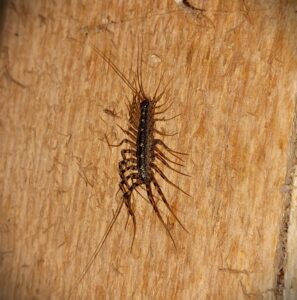House Centipedes
Friend or Foe?

House centipedes are about as unique a creature as you can find. Unique is a gentle way to describe the alien features of this little insect. They are only 1 to 1 ½ inches long, but the ridiculously long antennae and 30 fast-moving, extended legs give the impression of a much bigger bug. The last two legs are even longer than the rest, making it confusing to tell which end is the front and which is the back! As far as color, this variety is a subdued grayish-yellow with stripes. The striped coloration plus the long, frilly legs give the impression of being fuzzy, but that is not the case.
One of the weirdest things about this centipede is how it moves. Those 15 pairs of legs are exceptionally fast! (queue the shiver). Plus, the legs give the centipede in motion a rippling effect instead of the serpentine fashion of other centipede species. And get this, most centipedes use their legs primarily for catching and holding prey, but not the house centipede. This guy uses his legs as more of a sensory tool. Unique. I told you! But wait, there’s more!
Since I mentioned prey, let’s talk about what the house centipede eats and how he catches it. First of all, you need to know the centipede is solely carnivorous. He likes bugs. From fruit flies to small spiders, ants to roaches, earwigs, and silverfish, the house centipede is, in a sense, a tiny exterminator, as long as you don’t mind all those skittering little legs roaming your house in constant search of a meal.
Now, how do they hunt? Well, with tremendous speed and accuracy. They can travel 1.3 feet per second! Consider that from the perspective of a terrified ant. But how do they find the bugs? Those big antennae are more than cool appendages, they are used to sense the presence of prey. The antennae are so sensitive that smells and vibrations are both detected by their keen ability. Consider being able to give your fingers the ability to smell! Those long back legs have been observed to whip their prey into submission! The house centipede has poison fangs located on their first body segment they use to subdue their dinner with paralyzing venom before, well…you know, eating it. Their eyes are sensitive to light, and they are generally shy, which explains their preference to hunt at night. Seeing them out and about is fairly uncommon.
Now, let’s talk about where these many-legged insects live. Originally, it is believed they came from a Mediterranean climate, so they enjoy warmth and humidity. Amazingly, they have adapted to just about every climate. There are a wide variety of centipedes that live in cool places like the Scolopendra Cataractra which is amphibious, but before I digress…let’s stick to the house centipede.
The house centipede can certainly live outdoors and can be found behind rotting tree bark or under rocks and logs. As with all pests, the problem for homeowners is not the bug’s existence but the bug’s location.
Because the centipede prefers warm and humid, they may find your home to be the perfect spot to settle down.
Basements and bathrooms are hospitable environments for the house centipede and most often where homeowners find them. In our house, I’ve found the occasional centipede trapped in my sink or bathtub after falling in.
Now let’s get down to the pest control business part of this discussion.
Are house centipedes dangerous? Not unless you are a bug. If you’re a bug, I would be downright terrified; however, a human has little to fear from the sting of a house centipede. First of all, it is highly unlikely. Second, leave it alone or use caution if you are trying to remove it from your home. Centipedes can sting, and it can hurt so never say never. As with all stings or bites, everyone has a different reaction so by all means take whatever precautions and reactions you feel necessary. But for the most part, the answer is no, they are not dangerous to a human. As far as damage to your home, they do no damage.
Are centipedes helpful? Yes, they certainly are helpful. As mentioned, they are excellent pest control helpers if you can tolerate their presence.
But the reality is that most homeowners can appreciate the helpfulness but don’t actually want 30-legged, freaky fast centipedes as housemates. Same, friend, same.
Here’s the situation. If you have centipedes in your home, then you have other bugs in your home. The centipedes wouldn’t be there otherwise. Dinner and a movie, that’s their deal. The more centipedes you see, the more bugs you have. Therefore, if you have regular pest control service, you won’t have much issue with centipedes. Also, remember the humidity. Keep your home leak free and consider using a dehumidifier in areas like basements to keep that water-friendly atmosphere to a minimum. Watch out for cracks and crevices as well, since the roaming centipede might make its way inside just to check out the situation. House centipedes are solitary so no need to worry about large infestations.
Friends or foes?
Depends on your perspective I suppose. In their proper place, that’s outside, these marvelous creatures are to be applauded for their contribution to society. It’s when they move inside that we have a problem. Keep their food supply exhausted and the humidity in check, and house centipedes will not give you any problems!
If you have a problem with house centipedes or any other bug, give Canton Termite a call at 770-479-1598.
We want to help you live pest-free!
By: Robin
